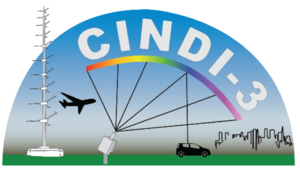TROLIX-19 and CINDI-3: Difference between pages
(update instruments) |
m (Changing campaign logo) |
||
| Line 1: | Line 1: | ||
{{Campaign | {{Campaign | ||
|title= | |title=CINDI-3 | ||
|description= | |description=Third Cabauw Intercomparison of Nitrogen Dioxide measuring Instruments, which took place at the Cabauw Experimental Site for Atmospheric Research (CESAR) from 21 May until 24 June 2024. CESAR is one of the main facilities of the Dutch Ruisdael Observatory located midway in between the cities of Rotterdam and Utrecht, and managed by KNMI. | ||
Over 100 researchers from 18 countries participated in CINDI-3, operating 32 UV-Vis DOAS instruments to compare and intercalibrate measurements of air pollutants and to support the validation of satellite measurements from space-borne instruments such as Sentinel-5p/TROPOMI. CINDI-3 is the third intercomparison campaign of this kind. The overall campaign planning and coordination was carried out by a steering committee, led by BIRA-IASB (Royal Belgian Institute for Space Aeronomy), coordinating the CINDI-3 intercomparison schedule and all additional activities such as the mobile and aircraft observations. | |||
The main science objectives of CINDI-3 are the following: | |||
- To assess the consistency of slant column measurements of several key target species (NO2, ozone, O4 and HCHO) of relevance for the validation of S5P and the future ESA atmospheric | |||
Sentinels, through coordinated operation of a large number of DOAS and MAXDOAS instruments from all over the world. | |||
- | - To study the relationship between remote-sensing column- and profile-measurements of NO2, HCHO and ozone and reference in-situ concentration measurements of the same species. | ||
- To investigate the horizontal representativeness of MAXDOAS measuring systems in view of their use for the validation of satellite tropospheric measurements featuring ground pixel areas in the range of 25-50 km2. | |||
- | CINDI-3 was organized as part of the ACTRIS-CREGARS Topical Center for trace gas remote sensing, within the framework of the collaboration between ACTRIS and NDACC, and conducted with additional support from ESA, NASA and from the EU Horizon2020 ATMO-ACCESS project (https://www.atmo-access.eu/). | ||
Additionally, the campaign was supported by KNMI. | |||
The following instruments were used: | |||
- Static MAXDOAS and zenith-sky DOAS instruments | |||
- In situ ICAD instrument | |||
- Brewer | |||
- Ozone sondes | |||
- NO2 sondes | - NO2 sondes | ||
- | - Lidar systems: The multiwavelength Raman lidar CAELI, UV-depolarisation lidar, Ceilometer, ESA EMORAL system, SMOL tropospheric ozone differential absorption lidar, NO2 differential absorption lidar, Mobile Aerosol Monitoring System (MAMS) and scanning AERONET photometer | ||
- | - Mobile DOAS instruments | ||
- | - Airborne measurements | ||
- | - Satellite data | ||
|atLocation=Cabauw | |atLocation=Cabauw | ||
|hasGeographicCoordinates=51.970271 N, 4.926209 E | |hasGeographicCoordinates=51.970271 N, 4.926209 E | ||
|startDate= | |startDate=2024-05-21 | ||
|endDate= | |endDate=2024-06-25 | ||
|landingPage=https://ruisdael-observatory.nl/cindi-3-intercomparison-campaign/ | |||
|landingPage=https://ruisdael-observatory.nl/ | |hasParticipant=ACTRIS, KNMI | ||
|hasParticipant=KNMI | |contributesTo=Static MAXDOAS and zenith-sky DOAS instrumentsStatic MAXDOAS and zenith-sky DOAS instruments | ||
|hasImage=CINDI3 logo.png | |||
}} | }} | ||
Revision as of 09:57, 5 September 2025
| Campaign: CINDI-3 | |
|---|---|

| |
| title | CINDI-3 |
| description | Third Cabauw Intercomparison of Nitrogen Dioxide measuring Instruments, which took place at the Cabauw Experimental Site for Atmospheric Research (CESAR) from 21 May until 24 June 2024. CESAR is one of the main facilities of the Dutch Ruisdael Observatory located midway in between the cities of Rotterdam and Utrecht, and managed by KNMI.
Over 100 researchers from 18 countries participated in CINDI-3, operating 32 UV-Vis DOAS instruments to compare and intercalibrate measurements of air pollutants and to support the validation of satellite measurements from space-borne instruments such as Sentinel-5p/TROPOMI. CINDI-3 is the third intercomparison campaign of this kind. The overall campaign planning and coordination was carried out by a steering committee, led by BIRA-IASB (Royal Belgian Institute for Space Aeronomy), coordinating the CINDI-3 intercomparison schedule and all additional activities such as the mobile and aircraft observations. The main science objectives of CINDI-3 are the following: - To assess the consistency of slant column measurements of several key target species (NO2, ozone, O4 and HCHO) of relevance for the validation of S5P and the future ESA atmospheric Sentinels, through coordinated operation of a large number of DOAS and MAXDOAS instruments from all over the world. - To study the relationship between remote-sensing column- and profile-measurements of NO2, HCHO and ozone and reference in-situ concentration measurements of the same species. - To investigate the horizontal representativeness of MAXDOAS measuring systems in view of their use for the validation of satellite tropospheric measurements featuring ground pixel areas in the range of 25-50 km2. CINDI-3 was organized as part of the ACTRIS-CREGARS Topical Center for trace gas remote sensing, within the framework of the collaboration between ACTRIS and NDACC, and conducted with additional support from ESA, NASA and from the EU Horizon2020 ATMO-ACCESS project (https://www.atmo-access.eu/). Additionally, the campaign was supported by KNMI. The following instruments were used: - Static MAXDOAS and zenith-sky DOAS instruments - In situ ICAD instrument - Brewer - Ozone sondes - NO2 sondes - Lidar systems: The multiwavelength Raman lidar CAELI, UV-depolarisation lidar, Ceilometer, ESA EMORAL system, SMOL tropospheric ozone differential absorption lidar, NO2 differential absorption lidar, Mobile Aerosol Monitoring System (MAMS) and scanning AERONET photometer - Mobile DOAS instruments - Airborne measurements - Satellite data |
| location | Cabauw |
| geographic coordinates | 51.970271 N, 4.926209 E |
| start date | 2024-05-21 |
| end date | 2024-06-25 |
| contact person (campaign coordinator) | |
| landing page | https://ruisdael-observatory.nl/cindi-3-intercomparison-campaign/ |
| participant organizations | ACTRIS, KNMI |
| contributes to datasets | Static MAXDOAS and zenith-sky DOAS instrumentsStatic MAXDOAS and zenith-sky DOAS instruments |
